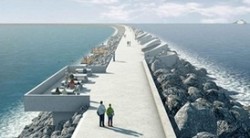Offsite manufacture is likely to play a part in the construction of the £1bn tidal power scheme off the coast of South Wales, a key figure has revealed.
Andrew McNaughton, director of engineering and construction at project promoter Tidal Lagoon Power, said factory-based building techniques would be used where suitable on Swansea Bay Tidal Lagoon.
McNaughton spoke to NCE after the pioneering scheme was granted a development consent order by the government last week.
Laing O'Rourke, last month named as preferred bidder for the contract to build the scheme's turbine house and sluice structure block, has invested heavily in offsite construction facilities.
McNaughton said: "Laing O’Rourke brings collaborative working and forward thinking, innovative methods. If we can use offsite manufacture then we will look to do so."
The former Balfour Beatty chief executive defended the appointment of Far East firm China Harbour Engineering Company (CHEC) as preferred bidder for the £300M marine works package on the Swansea project.
"CHEC is one of the top five dredging companies in the world," said McNaughton. "There is not a UK business which can do the job.
"As long as I’ve been in the industry, any major marine works that have taken place in the UK have been done by an international organisation."
He insisted there would be plenty of opportunities for Welsh workers on the tidal power scheme, which is expected to take three years to complete.
"Our intent is that a major part of the project will be done by local organisations," he said.
"The Chinese company will bring marine craft, but on-land works will all be done by local contractors. Only work needing dredgers and marine construction equipment will be done by the Chinese company – and even that may have some opportunities for local employment."
Plans for an even bigger tidal lagoon near Cardiff went to the Planning Inspectorate this spring.
"The turbine assembly plant will create jobs for local people and this is long-term employment as the number of turbines needed for the Cardiff scheme is higher than Swansea," said McNaughton.
The mood at the body aiming to build six tidal lagoons around the UK was "celebratory" after the planning approval for Swansea last week, McNaughton revealed.
"There are a huge number of things to do, and achieving the development consent order is just one step, but it is a gateway – it was pass or fail," he said.
The project promoter is still awaiting for a marine license to be approved by Natural Resources Wales, as well as for an agreement on a Contract for Difference to allow initial government subsidies of the power produced by the plant. In addition, some planning technicalities have been devolved to the Welsh government and Swansea council.
"We are aiming to be on site in spring 2016 and all the authorities we are working with are aware of that timetable," said McNaughton.
The firm earlier this year said it had hit its target of £220M of pledged equity, with the remaining £780M expected to be raised on the debt market.
"We have the equity providers but the quantum of debt and equity will be decided by due diligence process," said McNaughton. “We have prepared and engaged with banks through Macquarie. It's a process I am used to and we have enthusiastic banks and supportive investors."
Work is taking place to prepare for start on site fairly early in 2016.
"We have to get the team ready for site – advanced works are underway, mainly consisting of preliminary design, getting the cost plan robust, and agreeing contractor interfaces.
"There are some other building contracts to award for the visitor centre and other onshore buildings. The location of turbine assembly buildings needs to be finalised."
McNaughton said countries from around the world were watching the Swansea Bay project with interest. Tidal Lagoon Power and CHEC are to sign a memorandum of understanding for the development of tidal lagoons in Asia.
"We could see Tidal Lagoon Power working on a scheme in China," he said. "We aim to take UK engineering and expertise abroad.
"There is potential in China. Only Canada has a greater tidal range than the UK and we've had organisations and authorities from Canada monitoring our process. France and India have shown interest as well."
There are also those plans for projects in Cardiff, Newport, Colwyn Bay, Bridgwater Bay and West Cumbria.
"I joined the organisation because of the vision of creating a UK industry and the potential to export it," said McNaughton.
"Planning is a stepping stone. Each of the lagoons will have to go through its own process but we made it clear this was the first step in a programme.
"The aim is to have Cardiff approved and on site before we generate power from Swansea. We have to demonstrate the project is going smoothly."
The man who has worked on Heathrow Terminals 2 and 5, the widening of the M25 and the Channel Tunnel Rail Link is looking forward to his latest challenge.
"The project will be under scrutiny because it’s the first of a kind," he said. "The world is watching.
“As an engineer this is an amazing project to be involved in. I have done more complex projects but we will be building out at sea and the sea can be ruthless."
The project is due to be generating power in 2019.
Source: New Civil Engineer









